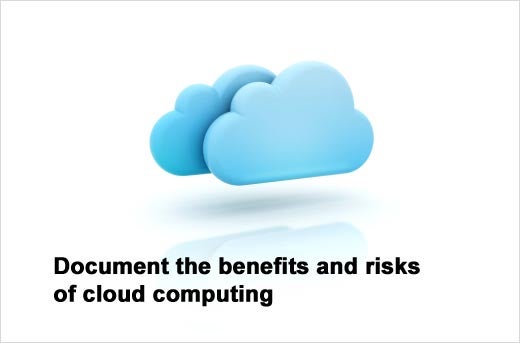With the introduction of x86 virtualization and the acceleration of cloud-based computing it is obvious to every techie that data center modernization is wicked cool, accessible to just about everyone, and beneficial to organizations of every size. Unfortunately, “wicked cool” and “beneficial” are terms that usually make CEOs cringe unless they are quantifiable with measurable benefits. The initial knee jerk reaction by any techie is to then explain how virtualization and cloud computing reduces costs, enables faster service delivery with better quality, and of course, how it makes the CEO’s life easier. This often prompts the CEO to just gaze into the eyes of the techie and say “OK, sounds interesting.” The disconnect often results in delayed or underfunded cloud projects because of the limited understanding of value, benefit, cost and return on investment (ROI) between the CEO and IT department.
IT admins understand how cloud computing can increase IT responsiveness and efficiency, reduce capital expenditures and operational overhead while providing greater business flexibility through an on-demand, pay-as-you-go model that provides infinite scale across multiple providers. It is IT’s responsibility to educate and equip the CEO on the strategic benefits and most importantly, the ROI. An expert resource for this slideshow is Jason Cowie, vice president of product management for Embotics, a pioneer in virtualization and automated private cloud management.
Click through for 10 steps that can help IT professionals get their CEOs up-to-speed on cloud benefits, as identified by Jason Cowie, vice president of product management for Embotics.
The keep it short and simple (KISS) principle applies to the CEO. Understanding the benefits associated with cloud typically begins by understanding and agreeing on what a cloud really is. Software as a service (SaaS), Platform as a service (PaaS) and Infrastructure as service (IaaS) are different cloud service models. To complicate matters, computer resources can then be on premises – or off premises – and can spread across private, public and hybrid cloud infrastructures.
Keep the educational session relatively short with the CEO by asking if the AppStore has changed the way he or she consumes and use applications. How long did it take to set up a Google email account compared to an internal Exchange email address? As a last resort, just pose the question, “Should I continue to buy $8,000 servers that will take one to two months to provision and will be obsolete in two to three years, or should I look at paying a monthly fee and have someone else refresh and maintain them?
Your CEO has been educated on risk avoidance and the importance of making strategic investments to support and enable the business. The various cloud service models present unique risks and benefits that should be clearly understood before kicking off any projects. Not all workloads are created equal and not all data is suitable for off-premises hosting (cloud computing), but private cloud service delivery models provide a more secure and acceptable boundary. Private cloud adoption is a great place to demonstrate and quantify cloud benefits while leveraging existing infrastructure investments.
Every CEO will appreciate, “I can do it without the cap-ex investment.” Whether you go with a public cloud or outsourced private cloud computing option, cloud computing delivers a better cash flow by eliminating the upfront capital expense associated with building additional data center infrastructure. This gives organizations the ability to farm out demand by leveraging external resources when it makes sense (seasonal fluctuations, project based demand, etc.).
Is your organization dependent on internal subject matter expertise? By augmenting your IT group team with external resources, you don’t need to continually add servers, storage, network and virtualization experts. You can augment your existing team with subject matter experts through your cloud provider while freeing up your internal team to focus on strategic initiatives.
The use of cloud computing models often removes the need for the potentially large capital and operating costs associated with purchasing or leasing such software and hardware, and shifts the costs to a usage-based model. Because cloud computing uses less physical resources, there is less hardware to power, cool and maintain. Additionally, cloud computing can simplify license agreements by consolidating them under the cloud provider, often leading to significant cost savings.
This allows small companies to compete more effectively with some of the larger businesses that have fatter IT budgets, thereby, helping to balance the playing field. Your small business can leverage the same computer resources that Fortune 100 companies use to gain competitive ground by only paying for what you use.
Cloud computing can be very quick and easy to get up and running. Pick a project that is well suited for cloud computing and deliver on a time line to prove out the model, while setting realistic and appropriate cloud computing expectations.
Data centers of most organizations are comprised of multiple layers of technologies, often cobbled together, that usually make revolutionary changes problematic. Take a pragmatic approach to cloud computing and emphasize to the CEO how it augments or leverages current infrastructure investments. Virtualization is turning out to be an enabler for better and faster delivery of IT services and cloud computing is just another evolutionary step towards doing things cheaper, better and faster.
Service and cloud providers have long embraced consumption-based chargeback models that have undoubtedly influenced internal IT to adopt similar models. Whether you adopt private or public clouds, it will be important to compare apples to apples, and not apples to oranges. Consumption-based metering and billing has long proven to drive conservation, good stewardship and overall cost savings. Does your CEO want to save money and promote accountability?
Ask your CEO if they would like that app to go? A cloud-based system substantially tears down traditional data center boundaries and increases the mobility and freedom of your employees and consultants. Mobility and social media provides organizations the ability to be continuously connected with the team no matter when or where they are.













